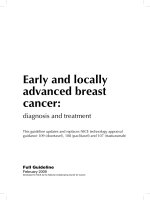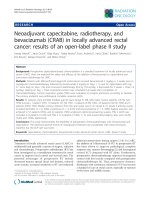Treatment results of locally advanced cervical cancer by external beam radiotherapy and low dose rate brachytherapy at Hue Central Hospital
Bạn đang xem bản rút gọn của tài liệu. Xem và tải ngay bản đầy đủ của tài liệu tại đây (168.16 KB, 7 trang )
Journal of military pharmaco-medicine no1-2019
TREATMENT RESULTS OF LOCALLY ADVANCED CERVICAL CANCER
BY EXTERNAL BEAM RADIOTHERAPY AND LOW DOSE RATE
BRACHYTHERAPY AT HUE CENTRAL HOSPITAL
Phan Canh Duy1; Nguyen Thanh Ai1; Pham Nhu Hiep1
SUMMARY
Objectives: To evaluate the outcome of external beam radiotherapy plus low-dose-rate
brachytherapy for locally advanced cervical cancer treatment in reccurrence, metastasis,
survivals and complications. Subjects and methods: A prospective study on 96 patients with
locally advanced cervical cancer treated by radical radiotherapy (external beam radiotherapy +
137
low-dose-rate brachytherapy using Césium) at Oncology Center of Hue Central Hospital from
2005 to 2012. Results: Common recurrence rate was 13.5%; local recurrence rate was 38.5%,
and extensive invasion was 61.5%; meantime of recurrence was 13.0 ± 11.9 months (1.5 - 36.0
months). Common metastasis rate was 16.7%; mean time of metastatis was 10.7 ± 7.5
months, lung metastasis was 25.0%, bone 25.0%, supraclavicular lymph node 18.8%, paraaortic
lymph node 12.5%, liver 6.3%. Mean overall survival was 6.3 ± 0.3 years. Mean follow-up
period was 4.1 years (0.3 - 7.6 years). 5 year overall survival was 75.9%; 5 year overall
survival of stage IIA was 85.7%, stage IIB was 80.2%, stage IIIA: 77.8% and stage IIIB: 65.5% (p
= 0.357). Post-radiotherapy complications: hemorrhage bladder inflammation was 1.0%, with the
time of occurrence was 22 months. Hemorrhage protitis was 5.2%, with mean time of occurrence
was 23.8 ± 3.9 months (18.0 - 28.0 months). Sacrococcyx ulcer was 1.0%, time of occurrence
was 10.0 months. Conclusions: External beam radiotherapy plus external beam radiotherapy
brachytherapy in treatment of locally advanced cervical cancer improved outcomes of
reccurrence, metastasis, complications, overall survival and disease free survival. Radioactive
137
source of external beam radiotherapy brachytherapy is
Césium that has a long half life,
therefore it is suitable for hospitals with fewer number of cervical cancer patients.
* Keywords: Locally advanced cervical cancer; External beam radiotherapy; Brachytherapy.
INTRODUCTION
Treatments for cervical cancer are mainly
radiotherapy, surgery and chemoradiotherapy
in combination, and radiotherapy is the
main and basic treatment modality, it is
described as “the spinal cord” of therapies
[1]. In 2005, we started applying low-doserate (LDR) brachythepay in cervical cancer
treatment at Hue Central Hospital [2].
\\\
In order to evaluate the outcomes after
treatment and long-term follow-up duration,
we carried out this study with two objectives:
- Evaluating the outcome of external
beam radiotherapy plus LDR brachytherapy
in cervical cancer treatment in recurrence,
metastasis and survivals.
- Evaluating the complications during
and after treatment.
1. Hue Central Hospital
Corresponding author: Pham Canh Duy ()
Date received: 20/10/2018
Date accepted: 07/12/2018
173
Journal of military pharmaco-medicine no1-2019
SUBJECTS AND METHODS
1. Subjects.
96 patients with locally advanced
cervical cancer treated by external beam
radiotherapy (EBRT) plus LDR brachytherapy
from 2005 to 2012, mean time of follow-up
was 4.1 years (0.3 - 7.6 years) at
Hue Central Hospital.
* Included criteria:
- Pathology was squamous cell carcinoma
or adenocarcinoma.
- Without concurrent chemoradiation;
no surgery before or after radiation.
- After whole pelvic external beam of
50 Gy, cervical tumor size was under 4 cm
and patients’ condition allows brachytherapy.
+ Performance status (PS) score was
0 to 2 [5].
* Excluded criteria:
- Patients disagreed to brachytherapy;
unsufficient radiotherapy.
+ Radiotherapy regimen: EBRT for the
whole pelvic of 50 Gy, followed by LDR
brachytherapy of 28 - 30 Gy/3 - 4 insertions
at point A.
RESULTS AND DISCUSSION
Radiotherapy is the main method for
treating cervical cancer including external
radiotherapy and brachytherapy. External
radiotherapy with high dose can affect on
adjacent urinary and digestive organs.
Besides, high-dose delivery can build up
at skin and tissues under the skin. To make
good the disadvantages of external
radiotherapy, since 2005, we have applied
LDR brachytherapy alone or combined
with the external radiotherapy. The
combination of low-dose brachytherapy
and external radiotherapy has got many
considerable values till now.
1. General characteristics.
Table 1:
Characteristics
- Patients had another type of cancer.
2. Methods.
Uncontrolled, randomized, prospective
study.
Age
* Materials:
- Clinical staging by FIGO 1995 [6].
- External radiotherapy using Chisobalt60 machine.
- Brachytherapy with Fletcher applicator,
137
Césium source.
- Dose volume histogram calculating
according to Plato Software of Radiation
Department, Hospital of SAINT LUC
University, Belgium.
174
Pathology
Clinical
stage
n
%
< 40
4
4.2
40 - 49
24
25.0
50 - 59
35
36.5
60 - 69
25
26.0
≥ 70
8
8.3
Squamous cell
carcinoma
83
86.5
Adenocarcinoma
13
13.5
IIA
11
11.46
IIB
40
41.67
IIIA
18
18.75
IIIB
27
28.12
Mean age was 55.2 ± 10.2; common
age was 40 - 69 (87.5%).
Journal of military pharmaco-medicine no1-2019
2. Recurrence.
Table 2: Recurrence status.
Recurrence status
n
%
Yes
13
13.5
No
83
86.5
Local
5
38.5
Recurrence
Sites of recurrence
Local + extensive
8
61.5
< 12 months
8
61.5
Time of recurrence
12 - 24 months
2
15.4
≥ 24 months
3
23.1
Average recurrence time was 13.0 ±
11.9 months (1.5 - 36.0 months); recurrence
before 2 years was 76.9%. Treatment
failure was the local recurrence. Many
researches finding’s had been reported
about the rate of local recurrence. In Kim
JC Park’s study, this rate was 23.9%,
39.53% [7]. In a nearly 17 years follow-up
study by Nguyen Thanh Ai on 258 patients
treated by external radiotherapy with
Chisobalt machine, the local recurrence
rate was 39.53% [1]. In a study by
Ngoc Linh Tran Dang (2000) when applying
the combination of Telecobalt external
radiotherapy and high dose brachytherapy
in 325 patients with cervical cancer,
the rate of local recurrence was 26.7%.
Besides, there was 10.9% of 109 patients
had recurrence after 3 years treated
with external radiotherapy and low-dose
brachytherapy [3]. In our study, the rate
was 13.5%. This result was lower than some
merely (alone/purely) external radiotherapy
studies and equivalent to other studies of
combination with brachytherapy.
3. Metastasis.
Table 3: Metastasis status.
Metastasis status*
Metastasis
Metastasis sites
Metastasis time
n
%
Yes
16
16.7
No
80
83.3
Liver
1
6.3
Bone
4
25.0
Supraclavicular node
3
18.7
Para-aortic node
2
12.5
Lung
4
25.0
Others
2
12.5
< 12 months
11
68.7
12 - 24 months
4
25.0
≥ 24 months
1
6.3
(*: 3 patients had both recurrence and metastasis)
175
Journal of military pharmaco-medicine no1-2019
General metastasis rate was 16.7%; mean time of metastasis was 10.7 ± 7.5 months;
metastasis before 2 years was 93.7%. In a study by Carlos A.Perez in 1986, 970 patients
had distant metastasis, after receiving external radiotherapy alone, 13% of whom
were at stage IB, 22% were at IIA and IIB, and 32% were at stage III [8]. In another
17 year follow-up study by Thanh Ai Nguyen, the common rate of metastasis in
258 patients treated by external radiation therapy with Chisobalt was 15.5%. Morever, the rate
of distant metastasis after 5 year was 46.7% in Ngoc Linh Dang Tran‘s study on
325 patients receiving the combined treatment of Telecobalt external radiotherapy
and high-dose brachytherapy in 2000 [3]. The rate of metastasis in our study was 16.7%,
lower than other studies due to the difference of the number of patients and clinical
stage.
4. Survival.
* Overall survival:
Overall survival
Graph 1: Overall survival.
Overall survival (OS) was 6.3 ± 0.3 years. Mean follow-up time was 4.1 years
(range: 0.3 - 7.6 years). OS rate after 1 year was 96.9%, 2 years, 3 years, 5 years and
7 years were 87.5%, 85.3%, 75.9%, and 75.9%, respectively.
176
Journal of military pharmaco-medicine no1-2019
* Five years OS by clinical stages:
Graph 2: Five year OS by clinical stages.
OS rate after 1, 3, 5, 7 year of stage IIA
were 100.0%, 100.0%, 85.7%, 85.7%,
respectively; of stage IIB were: 97.5%,
92.5%, 80.2%, 80.2%, respectively; of stage IIIA
were: 94.4%, 77.8%, 77.8%, 77.8%,
respectively and stage IIIB were 96.3%, 73.7%,
65.5%, and 65.5%, respectively (p = 0.357).
In Nguyen Thanh Ai‘s follow-up study for
17 years in 258 patients treated with
external radiotherapy by Chisobalt
machine, mean OS was 6.2 ± 0.4 years,
5 year OS was 40.7%, 10 year OS was
23.6% and 15 year OS was 18.2% [1]. In
another study of Tharavichitkul E that
combined external radiotherapy with highdosed brachytherapy from 2008 to 2011
with the same remedy, 3 year OS rate
was 93.6% and disease-free survival rate
was 85.1%. According to Ferringo R‘s study
in 190 patients first treated by
Telecobaltradiation therapy, then followed
by once or twice low-dose brachytherapy
with 137Césium from 1989 to 1995, OS
and disease-free survival rate after
70 months of patients in stage I, II and III
were 83%, 82% and 49%; 83%, 78%, and
46%, respectively. Kim J.C Park (1995)
reported the OS rate and disease-free
survival were 81.9% and 70.4% [7].
5. Complications.
Post-radiation complications included
haemorrhage, fibrinosis and ischemia of
tissue. Radiation at overall pelvic area
causes chronic bladder inflammation with
symptoms of fibrosis, urinary tract irritation,
bleeding. Besides, radiation can cause
vagina atrophy, making sexual contact
painful, rectal and sigmoid inflammation
causing pain and high risk of haemorrhage,
a minor of vagina-bladder or vaginarectum fistula due to increasing dosage at
cervical [9]. Post-radiation complications
are usually severe and hard to manage
which considerably affect patients’ life quality
and health [10].
177
Journal of military pharmaco-medicine no1-2019
Table 4: Complications.
n
%
Mean time of complications’
occurrence ± SD (month) (range)
Yes
1
1.04
22.0
No
95
98.96
Yes
2
2.08
No
94
97.92
Yes
5
5.21
No
91
94.79
Yes
1
1.04
No
95
98.96
Yes
1
1.04
No
95
98.96
Complications*
Haemorrhage bladder
inflammation
Protitis
Haemorrhage protitis
Fibrosis at radiation field
Cocco-sacrum ulcer
In our study, the complications in
radiation included: skin ulcer was 19.8%,
colitis was 63.5%, without complication
on bladder or rectum. Post-radiation
complications involved: heamorrhage bladder
inflammation was 1.0%, heamorrhage
protitis was 5.2%, fibrinosis at radiated
region was 1%, cocco-sacrum ulcer was 1%.
Thus, our result was equivalent to studies
of brachytherapy and lower significantly
than purely external radiotherapy studies.
In a study by Tharavichitkul E with
combination of external radiotherapy and
high-dose brachytherapy on treating cervical
cancer from 2008 to 2011 with the same
therapy, it was reported that the rate of
post-radiation complications at grade 3 - 4
of rectum and bladder was 2.1% and 2.1%,
without reported complication of fibrosis at
radiated area. The rate of complications
at rectum, small intestine and urinary
system after 5 years radiation was 16.1%,
4.6% and 7.6% in Ferrigno R’s follow-up
178
14.0 ± 11.3 (6.0 - 22.0)
23.8 ± 3.7 (18.0 - 28.0)
18.0
10.0
study [11]. In the same therapy with
purely external radiotherapy of Maduroa,
complications often occurred in the first
2 years after radiation and this rate
was 10%, the complication of urinary system
was above 10% and increased up to time
after treatment.
CONCLUSION
Randomized prospective study on
96 patients with locally advanced cervical
cancer treated by EBRT combined with
LDR brachytherapy at Hue Central Hospital
from 2005 to 2012, the results showed:
- Mean age was 55.2 ± 10.2, commonly
in group of 40 - 69 years old (87.5%),
histopathology mainly was squamous cell
carcinoma (86.5%), clinical stage IIB was
41.7%.
- Common recurrence rate was 13.5%;
mean recurrence time was 13.0 ± 11.9 months
(1.5 - 36.0 months).
Journal of military pharmaco-medicine no1-2019
- Common metastasis rate was 16.7%;
metastasis before 2 year was 93.7%;
mainly lung and bone metastasis.
- Mean OS was 6.3 ± 0.3 years. 1 year,
3-year, 5-year OS was 96.9%, 85.3%,
75.9%; 5-year OS of stage IIA was
85.7%, 5-year OS of stage IIB was
80.2%, 5-year OS of stage IIIA was 77.8%
and 5-year OS of stage IIIB was 6.5%.
- Late complications: No patients had
bowel and bladder inflammation, bladdervagina fistula or rectum-vagina fistula
after radiation. Other complications were
haemorrhage bladder inflammation, region
fibrosis related to radiation and sacrococcyx
ulcer were low (1.0%). Haemorrhage rectum
inflammation was 5.2%.
REFERENCE
1. Nguyễn Thanh Ái. Kết quả xạ trị ngoài
ung thư cổ tử cung. Tạp chí Y học lâm sàng.
2013, 17, tr.175-180.
2. Nguyễn Duy Thăng. Nghiên cứu dịch tễ
học mô tả một số bệnh ung thư tại Thừa
Thiên Huế giai đoạn 2001 - 2004. Tạp chí Y
học Thực hành. 2006, 541, tr.8-32.
3. Trần Đặng Ngọc Linh. Tái phát, di căn
của ung thư cổ tử cung giai đoạn IIB - IIIB xạ
trị đơn thuần. Y học TP. Hồ Chí Minh. 2007,
11 (4), tr.405-412.
4. Eifel P.J, J.S. Berek, M.A. Markman.
Carcinoma of the cervix. Principles & Practice
of Oncology. 2008, pp.504-1505.
5. Jason J. Smith, Paris P. Tekkis. Performance
status, risk prediction in surgery. 2014.
6. Globocan (IARC). Cervical cancer
estimated incidence, mortality and prevalence
worldwide in 2012. Section of Cancer Surveillance.
2014.
7. Kim J.C, Park. Comparison of the result
of radiation alone and chemoradiation in
cervical cancer. J Korean Soc Ther Rasiol Oncol.
1995, 13, pp.191-198.
8. Hacker N.F, M.L Friedlander. Berek and
th
Hacker's Gynecologic Oncology. 2008, 5
Edition, Chap 9, pp.342-388.
9. Maduroa J.H, E Prasa, P.H.B Willemseb.
Acute and long-term toxicity following
radiotherapy alone or in combination with
chemotherapy for locally advanced cervical
cancer. Cancer Treatment Reviews. 2003,
29 (6), pp.471-488.
10. Anthony H. Russell, Michael V. Seiden,
Linda R. Duska. Cancers of the cervix, vagina,
rd
and vulva. Clinical Oncology. 2004, 3 Edition,
pp.2217-2273.
11. Ferrigno R, Campos de Oliveira Faria,
Weltman E. Radiotherapy alone in the
treatment of uterine cervix cancer with
Telecobalt and low-dose-rate brachytherapy:
Retrospective analysis of results and variables.
2003, 55 (3), pp.695-706.
179









